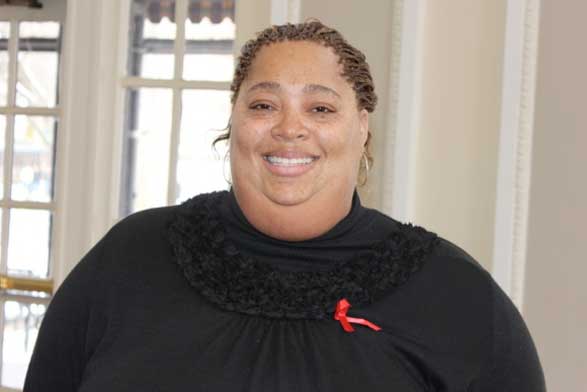
CLARISSE JORDAN
In the late 1980s when Clarisse Jordan contracted HIV, it was known to her and many others as the “gay White male disease.” She wasn’t gay, White, a prostitute, drug user, or any of the other identifiers used in the early days to categorize those living with HIV/AIDS.
She’d only had one partner, her boyfriend, but when her family discovered he had been diagnosed with HIV, her mother urged her to get tested.
“I went in and my doctor took the blood and it took a month and a half for the results to come back,” Jordan said. “I wasn’t worried.”
Today, Jordan is one of the more than 510,000 African-Americans living with HIV/AIDS in the United States and while Blacks make up 12 percent of the population, they represent 44 percent of total HIV/AIDS cases. She shared her story as part of the National Black HIV/AIDS Awareness Day event hosted by the University of Pittsburgh Graduate School of Public Health’s Minority Student Organization on Feb. 7.
“I’ve literally almost died 11 times. My mother never came to see me,” Jordan said after explaining how her mother kicked her out after she was diagnosed with HIV. “I’ve been positive for 28 years and my mother is just now able to ask me about my health.”
Jordan was in and out of the hospital from 1997 to 2006, but today her viral load, which measures the severity of the virus, is undetectable. Her t-cell count is high, which signifies the strength of her immune system, and she is down to 12 pills a day from her previous medicinal cocktail of 27.
“There’s nothing fun about having HIV; there is nothing pretty about it,” Jordan said. “The medicine basically makes you feel like you’re going crazy. Those are the side effects for me.”
The event also featured other speakers, workshop sessions and an informational fair about various efforts to raise awareness about HIV/AIDS in the Black community. Students were also invited to take advantage of free rapid HIV testing.
“I wanted to check my status. I wanted to be sure and I wanted to be able to say concretely whether I was positive or not,” said Zeba Ahmed, a junior, after she received her results. “I appreciate that there’s people making an effort to raise awareness about the risks.”
According to a 2011 report by the Urban League of Greater Pittsburgh, the Allegheny County Health Department and the University of Pittsburgh, African-Americans represent 12 percent of the Allegheny County population, but 44 to 46 percent of those affected by HIV/AIDS. Of the new cases of HIV/AIDS reported in 2007, 85 percent were African-Americans between the ages of 13 and19, and 58 percent are between the ages of 20-29.
“We’ve been planning this to bring awareness here to Pittsburgh, considering the statistics aren’t comforting,” said MSO President Beatrice Lors. “We’re the most affected, a large percentage of the African-Americans being infected are college-aged students.”
This event was hosted in partnership with the Regional Resource Network Program-US Department of Health and Human Services-Region III, Pennsylvania/Mid-Atlantic AIDS Education & Training Center, Central Outreach Resource and Referral Center, AIDS Coalition of Southwestern Pennsylvania, Educating Teens About HIV/AIDS, Allegheny County Department of Health, Urban League of Greater Pittsburgh, Pittsburgh AIDS Task Force, Pan-African Graduate & Professional Student Union, National Pan-Hellenic Council, and Black Action Society.